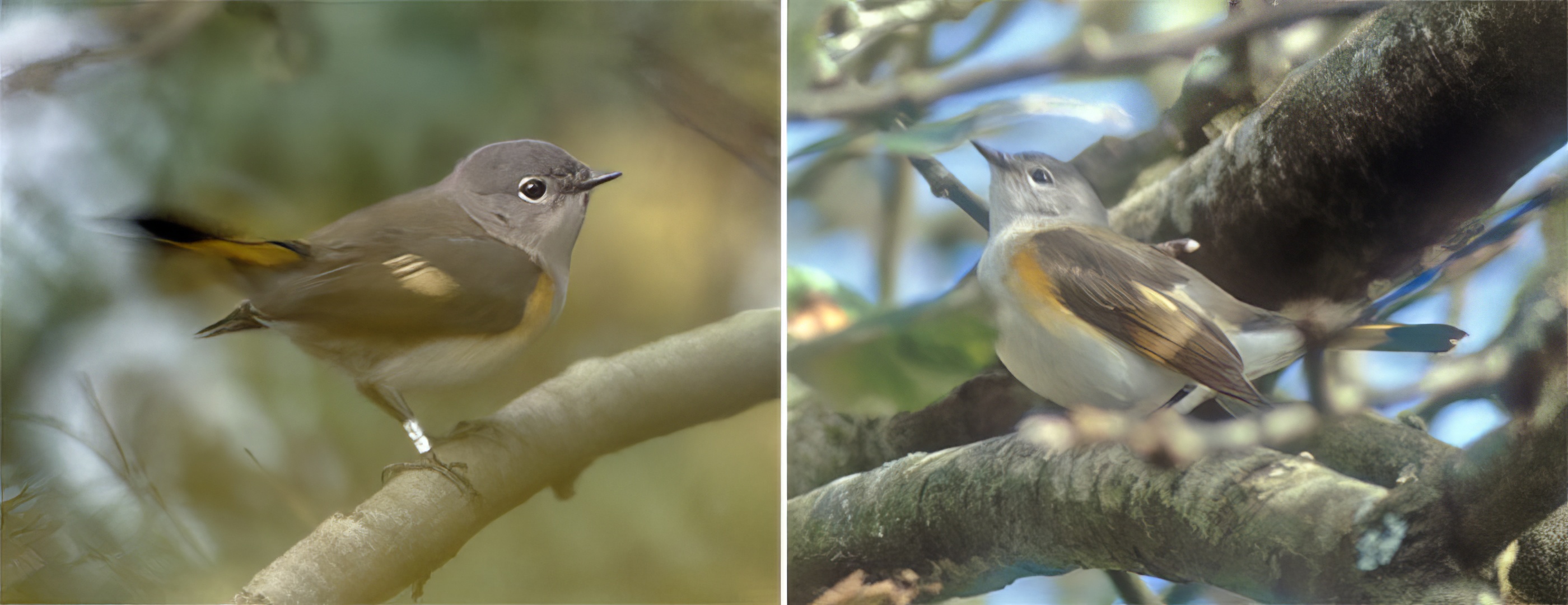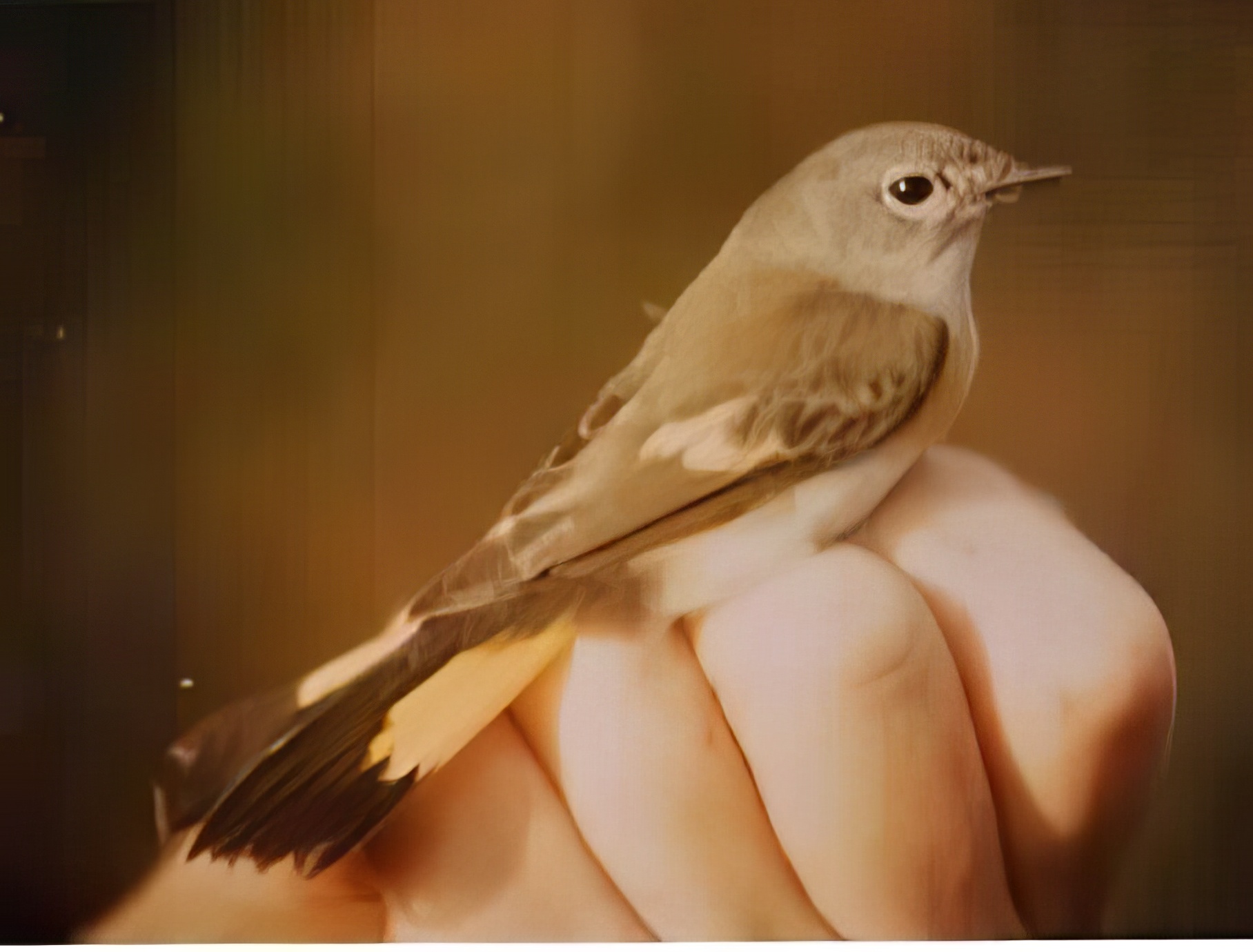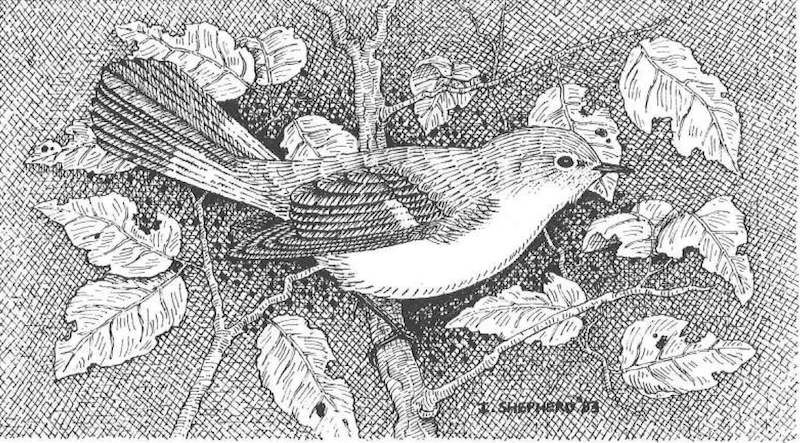American Redstart Setophaga ruticilla
Vagrant. North America.


American Redstart in the Plantation at Gibraltar Point November 7th 1982; left/centre Tim Loseby, right Mike Whiteside.
There has been one county record, at Gibraltar Point from November 7th November to December 5th 1982. The bird was found at 09.00h on November 7th frequenting Hawthorns Crataegus and Sallows Salix of the plantation. Although it was very active and frequently disappeared from view, often for long periods, it remained in a very restricted area of scrub, young trees and ivy-covered mature trees, both on this first morning and throughout its stay. Its flight was very buoyant, and flycatcher-like sorties made its presence very obvious; at other times, it fed with an action reminiscent of Sylvia warblers as it picked and probed its way along inner branches. The call, an often-repeated, slightly drawn-out 'tchip', was very distinct. It was the third British record of this American wood warbler. It is noteworthy that the second British record was only a week earlier on November 1st at Portnahaven on Islay, Strathclyde. Up to 2021, three more have been found in Britain, in Cornwall (October 1983), Hampshire (October 1985), and the Outer Hebrides (September 2017).
| Site | First date | Last date | Count | Notes |
| Gibraltar Point NNR | 07/11/1982 | 05/12/1982 | 1 | 1CY male, trapped and ringed 08/11/1982. |
American Redstart at Gibraltar Point, 7th November 5th December 1982: first county record.
By R. K. Watson

American Redstart, November 1982, Gibraltar Point; original sketch by Ian Shepherd
Circumstances
On November 7th, K. Winfield and I began our weekly visit to Gibraltar Point at dawn, with hopes of a mixture of the last autumn migrants and the continuing arrival of winter birds. Although the morning was mild, a moderate to fresh south- westerly was blowing as a trough of low pressure moved north-east across Britain. Another trough of low pressure which had been crossing the Atlantic was due to move into the south-west later that day, so due to the unsettled conditions we resorted to the cover of the west dunes and the farm.
By 08.00 hrs, rewarded with a small flight of Swallows, a Hen Harrier and three Whooper Swans we continued through the Sea Buckthorn bushes which bristled with feeding Blackbirds, the result of the previous day's fall. Working our way along the southern edge of the plantation in the grounds of the farm, we noted a small brightly marked warbler in a leafless hawthorn bush. It was immediately obvious that this was no ordinary warbler as it showed bright yellowish-orange patches on the sides of the breast just before and below the carpal joint, and a pale yellow wing bar. Only tantalizingly brief views were obtained before it disappeared into the thick cover of the hawthorns and cherries, but after five minutes it reappeared and slowly worked its way through the centres of the bushes towards us. Most of the time it busily flitted from branch to branch within the bushes but after a short period of preening it fanned its tail to reveal the bright yellow basal tail feathers with a dark centre. For twenty-five minutes we had intermittent views of the bird in good light conditions and a description was gradually pieced together.
Description
Warbler, size of a slim Blue Tit with a long tail about one third of total body length. Thin black bill; crown, nape, and ear coverts pale green, diffusing into white chin and throat; eye dark with pale orbital ring . Flanks buff with yellow patches just below the carpal joint. Breast and belly light buff to white around vent. Mantle, back and rump greyish with olive-green wash; wing darker than back with a pale yellow patch formed at the base of the outer secondaries . Yellow base to all but the central tail feathers for half their length, central and tips of the remaining tail features dark brown.
The bird was identified as an American Redstart and when returning to the area was soon located from its short clear monosyllabic "tchip" call. It called repeatedly as it flitted through the bushes eventually flying with tit-like buoyancy over our heads to a coppiced willow.
About noon on November 8th, the bird was caught in a mist-net and aged as a first winter male weighing 10g* About noon on November 8th, the bird was caught in a mist-net and aged as a first winter male weighing 10g . The bird was last seen on December 5th, having allowed several thousand observers to watch it at close range (Lambert et al 1985). This is the first record of the species for the county and the fourth for Britain and Ireland, the third being recorded at Islay, Strathclyde two days previously.
* In a study of habitat quality for wintering migrants in Jamaica (Johnson et al 2006), average weights of American Redstarts varied between 6.5-8.0g, with males heavier than females. This bird had therefore achieved a good weight and was presumably not a new arrival into the UK. It may well have made landfall further north and made good its weight loss before heading south along the east coast.
References
Johnson, M. D., Sherry, T. W., Holmes, R. T., and Marras P. P.(2006). Assessing Habitat Quality for a Migratory Songbird Wintering in Natural and Agricultural Habitats. Conserv. Biol. 20 (5): 1433-1444.
Lambert, R., Watson, R.K. and Winfield, K. (1985) American Redstart in Lincolnshire. British Birds 78: 245-246.
Watson, R.K. (undated) American Redstart at Gibraltar Point, 7th November-5th December 1982. Lincolnshire Bird Report 1982 pp.55-56.
(Account as per new Birds of Lincolnshire (2021), included September 2022)

